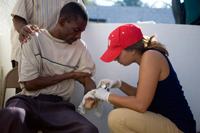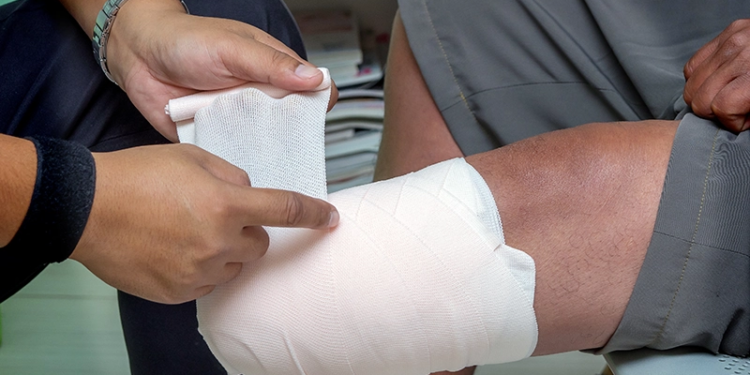
A Red Cross volunteer helps dress a Haitian man’s injury. Photograph by Talia Frenkel/American Red Cross.
Are you considering ways to help the potentially thousands of Haitian earthquake survivors who desperately need-or will soon need-O&P care? Providing care for the best long-term effect might require thinking outside the box of long-held practices and first instincts. Transporting patients to the United States, quickly assembling a volunteer team that includes your friends and neighbors, or sending all your used componentry directly into the country may sound like ideal ways to help but may cause serious short-term and long-term problems for the people you want to serve.
The Chair of the United States National Member Society of the International Society for Prosthetics and Orthotics (U.S. ISPO), Rob Kistenberg, MPH, CP, FAAOP, has written a statement to the O&P professional community that describes the situation in Haiti and lists the most effective avenues for providing quality care to the most people, both long-term and in response to immediate needs. He also lists several common practices to avoid. An edited version of his statement is below.
Prosthetics and Rehabilitation Services for People with Amputations in Haiti
A Message from the Chair of US-ISPO

As the enormity of the tragedy resulting from last week’s earthquake in Haiti comes into focus and the monumental task of search, rescue, and recovery continues, attention is being given to the immediate needs of the people amidst the chaos and destruction. As is often the case with catastrophic events, a significant number of survivors, possibly numbering in the thousands, will have sustained amputations. Even before the earthquake, the need for prostheses in Haiti far outstripped the capacity of the organizations providing prosthetic services.
Now, with a momentary shift of tectonic plates, the demand for prostheses and amputee rehabilitation has grown exponentially. Furthermore, the headquarters for the main group providing prosthetic care in Port- au-Prince, Healing Hands for Haiti (HHH), has sustained substantial damage.
As is the usual reaction to such a crisis, individuals and groups want to assist, which is noble and exactly what our natural instincts guide us to do. However, when it comes to providing prosthetic rehabilitation services to amputees in developing nations, one must be mindful of how these services are being delivered because it is possible to do more harm than good.
On January 19, 2010, a team from HHH, in conjunction with other international aid agencies, was deployed to Haiti to begin the initial coordination of rehabilitation for those with amputations and spinal cord injuries. Feedback from their initial, on-the-ground assessments should guide our next efforts. A systematic approach to amputee care there will include identification of the affected population concurrent with establishment and restoration of prosthetic facilities with adequate equipment, materials, and space to provide services.
The logistics of putting a humanitarian mission team in-country are daunting at the best of times but during a crisis and subsequent recovery, a coordinated effort is absolutely essential. Once the situation has been fully evaluated, plans can be made to assemble appropriate teams. There will be no shortage of volunteer opportunities once the infrastructure is in place.
While the United Nations Secretary General Ban Ki-moon describes the devastation in Haiti as “one of the worst humanitarian crises in decades,” it provides the international P&O rehabilitation community an opportunity to demonstrate our innate human compassion and our capacity to help people in dire need. An event such as this brings out the best in people, as is evident by the global response to this crisis. By providing systematic aid based on best practices, the P&O rehabilitation community can provide the most help to the most people. The practices described below-“parachute P&O” and patient transportation programs-are not recommended.
Parachute P&O Often Leaves Problems in Its Wake
Haitian people with amputations will need services for the rest of their lives. If teams fly into Haiti, find some way to deliver artificial limbs, and then return home, how will the patients receive follow-up care and adjustments?
In what is referred to as “parachute P&O” care, teams drop in, disrupt local facilities and activities, provide services, then fly out-leaving a group of people in their wake to effectively fend for themselves. People in Haiti with amputations need more than artificial limbs; they need prosthetic rehabilitation, including post-fabrication adjustments; physical conditioning; emotional, psychological, and post-traumatic stress disorder (PTSD) counseling; vocational rehabilitation, and social reintegration.
The challenge of gradually incorporating an artificial limb into the activities, body image, and daily routine of someone with a recent amputation is just as great-if not greater-than the challenge of making the prosthesis in the first place. If no one is there to provide post-fabrication adjustments or provide simple maintenance when something goes awry, the prosthesis can be rendered useless, painful, or worse-unsafe.
Patient Transport Programs-Resist This Temptation
Groups may be inclined to start transporting individuals to the United States for services. On the surface, this may seem like a good idea and convenient for the providers because they have their full facility at their disposal and host families get the benefits of opening their homes to someone in need. In the reality, this is far from ideal for a number of reasons.
First, practitioners tend to use componentry they are familiar with but that may not be appropriate for the patient’s home. At a prosthetic clinic in Belize, I have worked with more than one individual who has been “locked” into a prosthesis when the shuttle mechanism on a U.S.-made leg malfunctioned. In one case, a 13-year-old girl could not get her leg off for three days and nights. Her father, desperate to alleviate her suffering, almost tried to remove it with a hacksaw before he was referred to the clinic. In the United States, if a component malfunctions, a prosthetist is only a phone call away. In the developing world, component malfunction may create very serious problems.
Second, traveling overseas to a foreign country for prosthetic care can be disorienting. Imagine that you come from the poorest country in the Western Hemisphere, survived the earthquake’s unimaginable devastation only to lose an arm or leg, and an organization drops a golden ticket in your hand that will take you away to a developed country for perhaps six weeks, with a promise of a prosthesis, housing, food, and sudden immersion into a world of hereto-unknown creature comforts. For a short period, being freed from worries about basic necessities of food, shelter, and clothing leaves you feeling phenomenal…until the time for your return home looms nearer. Perhaps a taste of honey is worse than none at all.
Third, upon returning home, those transported for services are often left with a sense of abandonment. When overseas, they are surrounded by caring people in a wonderfully sheltered environment, and then they are thrust back home, alone. Some patients faced with returning home in this circumstance flee their hosts, preferring to take their chances as an illegal alien rather than return home.
In short, while host families and facilities would be denied the rewarding experience of providing prosthetic rehabilitation for a foreigner, dollars spent on flights, visas, housing, and food would be better spent supporting efforts to develop prosthetic infrastructure in Haiti.
Appropriate Technology
Appropriate technology takes into account the environment in which the devices are going to be used, the availability for follow-up care and maintenance, costs, and the level of training of those providing the prostheses as well as those providing follow-up care. Providing appropriate technology means that the amputee population has a better chance to receive limbs, physical therapy, and on-going rehabilitation care.
The International Committee of the Red Cross (ICRC) and other organizations have developed cost-effective and user-friendly technologies for the developing world. These tested techniques and technologies will be the best place to start to meet the urgent need. New or recycled componentry may also have a place depending on how, where, and by whom it’s applied.
How to Help Now
- Volunteer: This is the time to launch a coordinated effort to build strong, sustainable O&P capacity in Haiti. If you are willing to go to Haiti now or in the future, join HHH’s database of volunteers by filling out the Healing Hands for Haiti volunteer form.
- Commit to doing it right: If you and or your organization is seriously interested in assisting with P&O humanitarian efforts in Haiti or anywhere, read and sign on to the P&O Code of Conduct for Humanitarian Organizations at www.usispo.org/code.asp. Also, look for an upcoming U.S. ISPO seminar on best practices for international humanitarian O&P care to be hosted in 2010 by St. Petersburg College, Florida.
- Donate components, equipment or materials: If you have componentry, new or used prostheses, or fabrication materials or equipment, please donate them through the Prosthetic & Orthotic Component Clearinghouse (POCC). What you send may or may not be appropriate for Haiti.
- Give cash: Contributing money to Healing Hands for Haiti, UNICEF, or the Red Cross can be a highly effective way to create change.
To read Kistenberg’s full statement, visit www.usispo.org




